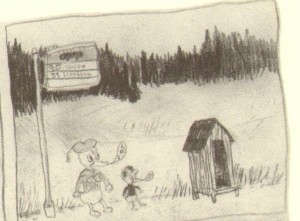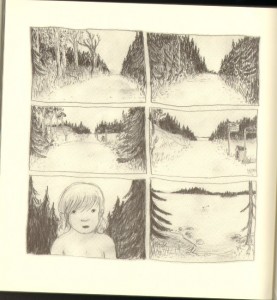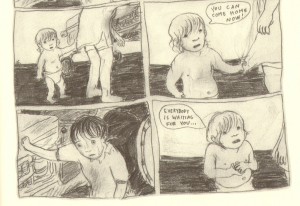Over the past couple months my comics reading has mostly consisted of manga with a handful of American titles that have nothing to do with superheroes. I stopped following mainstream superhero comics some time ago, on account of the bad art, endless crossovers, etc., etc. But there is a part of me (the foolish, masochistic part) that would like nothing better than to sit back and read a truly enjoyable superhero story.
That’s why I’m returning to first principles. And by first principles, I mean Hulk smash. Originally, I planned to read the popular Planet Hulk storyline by writer Greg Pak and artist Carlo Pagulayan. But then Marvel did me a favor by adapting the story into a cartoon, so now I don’t have to read anything!
For those not familiar with the story, it begins with the heroes of Earth, led by Iron Man, deciding that they’ve had enough of the Hulk and his smashing. So the heroes come up with a perfectly sensible, if not exactly heroic, plan: they load the Hulk onto a rocket and shoot him into space. To be fair, the heroes intended for Hulk to land on a verdant paradise uninhabited by intelligent beings. Of course, things don’t go as planned and Hulk crashes on a barren world called Sakaar. He’s immediately captured by slavers and forced to fight as a gladiator for the amusement of the evil Red King. After some success as a gladiator, the Hulk reluctantly takes charge of a rag-tag team of slaves and rebels struggling to overthrow the tyrant. It’s basically Gladiator with the Hulk instead of Russell Crowe, which I consider an improvement. The plot is predictable, but that’s not necessarily a terrible thing in an action flick.
But there are problems with adapting a fairly long comic storyline into an 80 minute movie. First, there’s a painful amount of expository dialogue, and yet most of it seems unnecessary given the simplicity of the plot. Another problem is that there are at least half a dozen major supporting characters that need to be introduced, and several of them get substantial flashbacks. But the characters still feel like strangers by the end of the movie because there simply isn’t enough time to show viewers why anyone besides the Hulk matters. The 80 minute runtime produces a movie that is, at once, too long for its simple story and yet too short to effectively establish its universe and characters.
The time crunch is further exacerbated by some incredibly misguided fan-service. One of the flashbacks consists of aliens fighting Thor for what feels like half an hour. To call it tangential to the plot would be generous. Now, I’m sure there are plenty of Marvel fanboys who squeal whenever Thor shows up, but the scene wasted precious time that should have been devoted to the Hulk. But at least a fair number of non-fanboys actually know who Thor is. In an even stranger decision, the movie includes a lengthy fight sequence with Beta Ray Bill of all people. Again, I’m sure there are a couple fanboys out there who think that everything is better with Beta Ray Bill. They are wrong. His appearance feels awkward and the Hulk come across as a guest star in his own movie.
Also, the dialogue is really bad. Obviously, this is a Hulk movie, and I wasn’t expecting Hamlet. But there’s no reason why all the characters have to speak in the same insufferably earnest manner. There’s no humor, no enthusiasm, no personality, not even the little character ticks that Stan Lee would throw in.
The animation is better than the writing, though it has its share of flaws. Rather than attempting a highly detailed style, Planet Hulk rips off the character design style introduced by Bruce Timm and used extensively in DC animation. This is actually a good thing; if you’re going to steal, steal from the best. The characters have a sleek, minimalist look that works well in action-driven animation. The backgrounds are given more detail, though they’re rather generic sci-fi.
But the animators can’t hide the fact that they’re working on a tight (direct-to-video) budget. During the action scenes, it often seemed like “frames” were missing from the film. The animators probably didn’t have enough time or resources to draw a sufficient number of cells so that the movements would appear quick and fluid. Instead, The action is often choppy, characters move sluggishly, and frequent edits are used to hide these faults. The cumulative effect is that the fights feel small and disconnected from their environment. The action sequences are presumably the main selling point of the movie, but they’re not much of a selling point, unfortunately.
Despite my panning, I know some people might still want to watch Planet Hulk with their kids, so I’ll comment on the age-appropriateness. Way back in the good-old-days, Noah criticized the Wonder Woman animated feature for being too violent for young kids and yet limiting that violence in rather obvious and cowardly ways (probably so that the movie wouldn’t be completely inappropriate for younger viewers). Planet Hulk is also too violent for young kids, but it doesn’t half-ass it. There’s a stunning amount of graphic violence for a PG-13 movie, and it’s far more gory than either Wonder Woman or the live-action Incredible Hulk (I’m not exaggerating, if you don’t like blood, this isn’t the movie for you). So it’s probably not appropriate for the youngest viewers, but teenage boys will love it.
If I were to rank Planet Hulk in comparison to recent DC animated features, I’d say it’s better than the profoundly stupid Superman/Batman, but it lacks the technical polish of Wonder Woman (flawed as the story was, it had great animation) or Green Lantern: First Flight.




